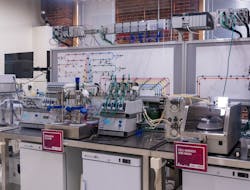How do you give life to a new industry? There’s a short list of individuals experienced in parenting a disruption of such magnitude. Elon Musk, Mark Zuckerberg, Steve Jobs and Bill Gates come to mind immediately. Dean Kamen, founder of FIRST Robotics and Segway, as well as Deka Research and Development, is an equally disruptive force.
“I pointed out to President Barack Obama that the difference between scientific research and industry is huge,” he explained, during a tour of BioFabUSA, which he spearheaded, in Manchester, New Hampshire. “We don’t even have the real roots of the industry that is going to take the science out of these labs and bring it to industry,” he told Obama.
The Advanced Regenerative Manufacturing Institute (ARMI), a member-driven, 501(c)(3) nonprofit organization, created BioFabUSA, one of 16 Manufacturing USA institutes, born from a federal initiative that originated during the Obama administration. BioFabUSA integrates cell and tissue cultures with advances in biofabrication, automation, robotics and analytical technologies to create disruptive tools and scalable FDA-compliant manufacturing processes.
“When we first started ARMI, I said the dynamic range of people getting involved was going to be unprecedented. We grew to well over 100 members in a few years,” said Kamen. “To get an industry up from nothing, we’re going to need standards. We’re going to need systems. We need to create that substrate. We need this massive infrastructure to turn this into a high-volume business.”
Staffed by 67 employees, as well as embedded employees from more than 200 member companies, BioFabUSA has grown quickly since its inception in 2017. ARMI began with an $80 million grant from the U.S. Department of Defense and a handful of member companies. Kamen’s vision is to not only facilitate the ability to grow human tissue for organs, but to automate the process and then democratize it to the point of providing machinery small enough to place in a doctor’s office.
“I told the Department of Defense I have mechanical engineers, system engineers, controls engineers,” explained Kamen. “I don’t have a single MD in my company. We know nothing about the world of synthetic biology. We know the engineering side of a lot of these things we do.”
Kamen set to work on recruiting leaders to steer the institute into disruptive waters. “I called John Abele, the co-founder and director of Boston Scientific,” he said. “I called Martine Rothblatt, United Therapeutics CEO and the founder of Sirius Satellite Radio. The third person I called was Blake Moret, the CEO of Rockwell Automation. I knew him through FIRST Robotics.” Along with Dr. Jim Weinstein, senior vice president for Microsoft Healthcare and former CEO of Dartmouth-Hitchcock, these five became the BioFabUSA board of directors.
Automation fills important role
Among the embedded people at ARMI/BioFabUSA are Rockwell Automation employees including Wayne Charest, bio manufacturing automation specialist, and John Hatzis, global industry technical consultant, life sciences. “When we first came onboard, we were among the first to join ARMI in 2017,” said Charest. “The first year, ARMI was a manufacturing institute, which was made up by its members. We spent a lot of time the first year trying to teach the members about automation. We created a program called Automation 101.”
After the first year, Charest helped to create the tissue foundry, which was the first automated tissue line. Rockwell Automation supplies the technology that automates the tissue foundry. “Then we decided to build an experience center. We couldn’t have gotten those done in the first five years without John Hatzis.”
Hatzis works with a variety of life-sciences companies. “We are getting to see the beginnings of an industry right here in New Hampshire,” he said. “It’s been a great experience building these tissue factories.”
Rockwell Automation’s technology has become an integral driver of the scalable, modular, automated, closed (SMAC) system that’s taken shape under the leadership of Tom Bollenbach, ARMI/BioFabUSA’s chief technology officer.
Biofabrication is the industrial production of biological tissues that can be used for infinite therapeutic applications, including for burn injuries or damaged vasculature, in toxicology screening to test the safety of drugs under development and to develop therapies to cure diseases including renal failure and diabetes.
Generating cells is relatively easy, compared with the complexities of regenerating three-dimensional organs, such as kidneys, livers, hearts or lungs, all of which are in the works by ARMI member companies, explained Bollenbach. “How do you quality-control living tissue?” he asked rhetorically. The challenges come specifically in determining how to transport fuel—nutrients and oxygen, for example—to interior cells and how to subsequently remove waste products.
Data has become a key enabler for finding correlations that help to predict behaviors in cells that need to accomplish these types of goals. Digital technology keeps moving the needle. “Fifty years ago, people scoffed at what you would need a computer for,” explained Kamen. “We’ve digitized the world in a way that people wouldn’t have predicted in the days of transistors.”
Kamen compared the potential impact of democratized organ regeneration to the way wireless communication has changed our lives. “There are 2 billion transistors in a cellphone,” he explained. “There are about 2 billion cells in a pancreas. What would you pay for a new pancreas for your child? The United States is going to spend 21% of its GDP on healthcare, mostly on chronic treatments. If we build an industry that allows people to replace organs, it will be more impactful on people’s lives than cellphones.”
About the Author
Mike Bacidore
Control Design

Leaders relevant to this article:
